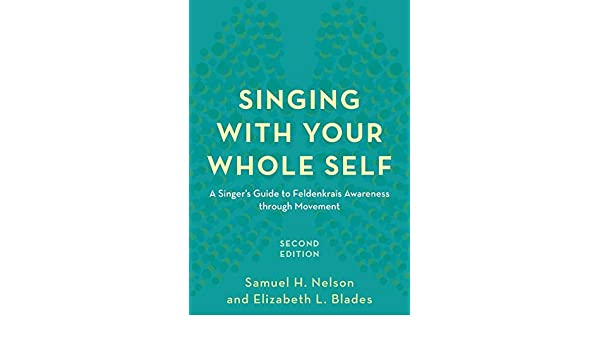Looking for a how-to guide on the Feldenkrais Method and singing? If so, grab yourself a copy of Singing With Your Whole Self: A Singer’s Guide to Feldenkrais Awareness through Movement, writes Alexa Terry.
“How does one develop an internal feel for what sounds good? How do you learn to use all of yourself when singing? What is the relationship between the felt (kinaesthetic) sense, effort, and good sound?” (Samuel H. Nelson and Elizabeth L. Blades, authors of Singing with Your Whole Self: A Singer’s Guide to Feldenkrais Awareness through Movement)
Mechanic, physicist and judo black belt Moshe Feldenkrais founded the Feldenkrais Method after a chronic knee injury threatened to consign him to a wheelchair.
He used his knowledge of engineering and physics to create a body-centred system to increase self-awareness and encourage efficient body movement.
Feldenkrais techniques help us to consider our bodies less like a foreign vessel, and more as a conscious part of our self. Therefore, as singing includes the whole body, the Feldenkrais Method can be applied to the singer.
It can help singers to pair effortless internal sensations (often described as the feeling of ‘nothing’) to their desired product.
Vocal coaches who are eager to learn how to incorporate Feldenkrais into their teaching should start with a copy of Singing with Your Whole Self by Samuel H. Nelson and Elizabeth L. Blades.
About the authors
Samuel H. Nelson is a Feldenkrais practitioner who runs a private practice in the US and teaches at several institutes. Elizabeth L Blades is a renowned music professor and voice researcher.
Nelson and Blades are the authors of two separate works. He wrote Playing with the Entire Self: Feldenkrais Method and Musicians. She’s the author of A Spectrum of Voices: Prominent American Voice Teachers Discuss the Teaching of Singing. Their joint effort, Singing With Your Whole Self, was first published in 2001. The second edition followed 17 years later.
In a nutshell
This book is an eye-opening insight into the holistic interrelation of human anatomy and its impacts on singing. It acts as a friendly Feldenkrais tour-guide and details techniques you can easily apply in a voice lesson. My volume will be dog-eared from much use.
What this book is and is not
This book is:
- A great resource to learn about the Feldenkrais Method, the story behind it and what it entails.
- Useful to help understand the power of imagination, intent and discovering effortless effort.
- A helpful guide to understanding the body’s domino effect.
- Great if you’re looking for a set of exercises to increase self-awareness and improve vocal efficiency.
This book is not:
- A scientific account nor an anatomically detailed resource.
- An exploration of the Functional Integration aspect of the Feldenkrais Method (which involves physical contact).
- A dry account, written in an academic style.
Stepping into the pages
This book provides:
- An overview of the Feldenkrais Method.
- Insight into the importance of developing true self-representation aka kinaesthetic awareness for performance efficiency and for the accessibility of mental practice
- An explanation of finding the ability to reduce effort but maintaining intent.
- A discussion of the brain’s re-organisational process, aka neuroplasticity, and the way Feldenkrais can restructure particular functions. The aim is to rewire negative habitual behaviours to create something more efficient.
- Insight into finding a ‘dynamic balance’ and the importance of the feet.
- An exploration of the pelvis which is considered the source of anatomical power.
- A discussion on the breathing mechanism and the influences from surrounding structures. The phrase ‘tension anywhere is tension everywhere’ has stuck with me.
- Observation on the interrelationship of the hands and mouth, and how this connection derives from the foetal state.
- Details on the effect of relaxing the eyes on the nervous system as a whole.
- Anecdotes and the telling of Awareness Through Movement (ATM) successes.
- A brief insight into a study conducted with spectrographic feedback regarding the impacts of ATM exercises on the singer.
- An appendix which lists the ATM exercises in order of most significant impact, and those that concentrate on a particular area.
Practical ATM exercises included:
- Freeing the neck to turn easily
- Kinaesthetic Imagination
- Letting go and gaining passive control
- Controlling tension levels in the form of ‘taming the tongue’
- Neuroplasticity focus
- Finding balance
- Distributing weight evenly across both feet
- Aligning the pelvis as the energy source
- Discovering a balanced upright posture in sitting (to avoid slouching or hyperextension)
- Finding a helpful breathing approach
- Lengthening the lungs and freeing the pleura (suitable for those with respiratory difficulty or recovering from a respiratory illness)
- Freeing up the ribs for effective breath function
- Spinal mobility in the lateral plane
- ‘Evening the sides’ (helpful for scoliosis)
- Shoulder and torso relationship (and the domino effect on surrounding links)
- Releasing tension in elevated shoulders (one of my personal favourites!)
- Shoulders and their relationship with breath function
- Head balance
- Relationship between the shoulders, neck and jaw
- Releasing neck tension (proven successful in relieving tension headaches. This can be quite magical, and may even save you a fortune on paracetamol)
- Liberating the hands and wrists (which can, in turn, reduce tongue and shoulder tensions)
- Releasing the mouth to find freer articulation (and so less laryngeal restriction)
- Opening the airways (with attention on the nostrils)
- Relaxing the eyes
- Relationship between the eyes and jaw
Warning: Don’t try these out on your unwilling or sceptical husband/wife/partner; arguments may ensue.
The Feldenkrais Method can act as a singer’s interpreter to help them communicate with their own body. This way, the individual is guided by their sensations and experiences and not dictated by a second body (the teacher) or vocal myths. Using exercises like the ones described in Singing With Your Whole Self can help turn responses such as ‘how did that feel?’ from a measly ‘okay’ into something more comprehensive.
The ATM exercises are suitable for group and choir scenarios and one-to-one sessions. The authors describe them as “simple, gentle, pleasant and fun”. All of which I agree with – except maybe the latter. I can’t say the exercises filled me with much excitement. The repetitive nature was a little dull, regardless of the insightful exploration or result of the activity. Perhaps this was due to working solo. In a team setting, the exercises may feel more enjoyable.
Through their descriptions of how anatomical structures are interlinked, Nelson and Blades have produced a guide useful in finding a fitting vocal diagnostic. The co-authors have succeeded in their intentions of presenting an accessible handbook to be used into the vocal lesson. It will be a trusty sidekick in my practice.
Complementary resources
– Awareness Through Movement by Moshe Feldenkrais.
– Musicophilia by Oliver Sacks – A book based on the relationship between the brain and music.
– The Brain That Changes Itself: Stories of Personal Triumph from the Frontiers of Brain Science by Norman Doidge.
– The Brain’s Way of Healing: Remarkable Discoveries and Recoveries from the Frontiers of Neuroplasticity by Norman Doidge.
– The Thinking Body by Mabel Elsworth Todd.
– How Feldenkrais Can Help Singers. Article published by iSing Magazine.
– BAST’s interview with craniosacral practitioner Caroline Laurence.
If you have any questions or comments you can share them on the BAST Trainers Facebook group.




